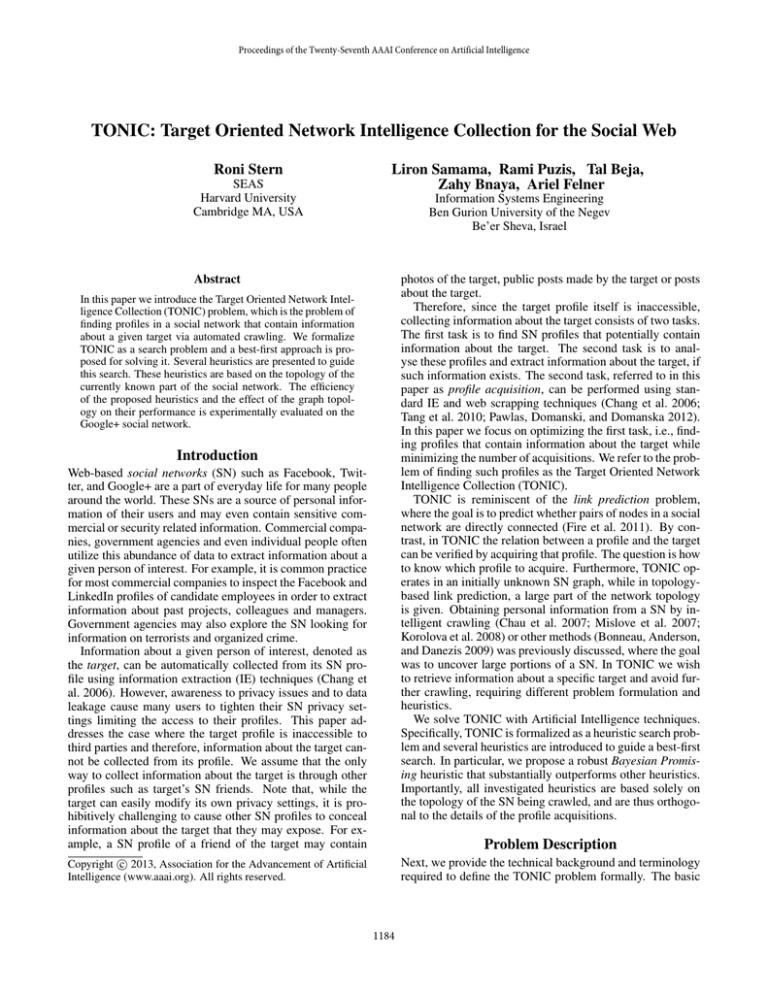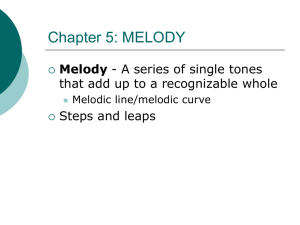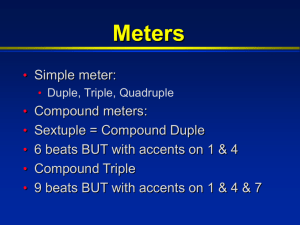
Proceedings of the Twenty-Seventh AAAI Conference on Artificial Intelligence
TONIC: Target Oriented Network Intelligence Collection for the Social Web
Roni Stern
SEAS
Harvard University
Cambridge MA, USA
Liron Samama, Rami Puzis, Tal Beja,
Zahy Bnaya, Ariel Felner
Information Systems Engineering
Ben Gurion University of the Negev
Be’er Sheva, Israel
Abstract
photos of the target, public posts made by the target or posts
about the target.
Therefore, since the target profile itself is inaccessible,
collecting information about the target consists of two tasks.
The first task is to find SN profiles that potentially contain
information about the target. The second task is to analyse these profiles and extract information about the target, if
such information exists. The second task, referred to in this
paper as profile acquisition, can be performed using standard IE and web scrapping techniques (Chang et al. 2006;
Tang et al. 2010; Pawlas, Domanski, and Domanska 2012).
In this paper we focus on optimizing the first task, i.e., finding profiles that contain information about the target while
minimizing the number of acquisitions. We refer to the problem of finding such profiles as the Target Oriented Network
Intelligence Collection (TONIC).
TONIC is reminiscent of the link prediction problem,
where the goal is to predict whether pairs of nodes in a social
network are directly connected (Fire et al. 2011). By contrast, in TONIC the relation between a profile and the target
can be verified by acquiring that profile. The question is how
to know which profile to acquire. Furthermore, TONIC operates in an initially unknown SN graph, while in topologybased link prediction, a large part of the network topology
is given. Obtaining personal information from a SN by intelligent crawling (Chau et al. 2007; Mislove et al. 2007;
Korolova et al. 2008) or other methods (Bonneau, Anderson,
and Danezis 2009) was previously discussed, where the goal
was to uncover large portions of a SN. In TONIC we wish
to retrieve information about a specific target and avoid further crawling, requiring different problem formulation and
heuristics.
We solve TONIC with Artificial Intelligence techniques.
Specifically, TONIC is formalized as a heuristic search problem and several heuristics are introduced to guide a best-first
search. In particular, we propose a robust Bayesian Promising heuristic that substantially outperforms other heuristics.
Importantly, all investigated heuristics are based solely on
the topology of the SN being crawled, and are thus orthogonal to the details of the profile acquisitions.
In this paper we introduce the Target Oriented Network Intelligence Collection (TONIC) problem, which is the problem of
finding profiles in a social network that contain information
about a given target via automated crawling. We formalize
TONIC as a search problem and a best-first approach is proposed for solving it. Several heuristics are presented to guide
this search. These heuristics are based on the topology of the
currently known part of the social network. The efficiency
of the proposed heuristics and the effect of the graph topology on their performance is experimentally evaluated on the
Google+ social network.
Introduction
Web-based social networks (SN) such as Facebook, Twitter, and Google+ are a part of everyday life for many people
around the world. These SNs are a source of personal information of their users and may even contain sensitive commercial or security related information. Commercial companies, government agencies and even individual people often
utilize this abundance of data to extract information about a
given person of interest. For example, it is common practice
for most commercial companies to inspect the Facebook and
LinkedIn profiles of candidate employees in order to extract
information about past projects, colleagues and managers.
Government agencies may also explore the SN looking for
information on terrorists and organized crime.
Information about a given person of interest, denoted as
the target, can be automatically collected from its SN profile using information extraction (IE) techniques (Chang et
al. 2006). However, awareness to privacy issues and to data
leakage cause many users to tighten their SN privacy settings limiting the access to their profiles. This paper addresses the case where the target profile is inaccessible to
third parties and therefore, information about the target cannot be collected from its profile. We assume that the only
way to collect information about the target is through other
profiles such as target’s SN friends. Note that, while the
target can easily modify its own privacy settings, it is prohibitively challenging to cause other SN profiles to conceal
information about the target that they may expose. For example, a SN profile of a friend of the target may contain
Problem Description
Next, we provide the technical background and terminology
required to define the TONIC problem formally. The basic
c 2013, Association for the Advancement of Artificial
Copyright Intelligence (www.aaai.org). All rights reserved.
1184
entity in TONIC is the profile, which is associated with a
specific SN (e.g., Facebook or Google+). Profiles are connected to each other via a “friendship” relation. The list of
“friends” (LOF) of a given profile p is denoted by LOF(p).
We denote profiles that contain information about the target as leads. A profile p is a lead if (1) the target is contained in LOF (p), or (2) p contains a post by the target,
or (3) the target is tagged in one of the photos shown in
p. Other criteria for determining whether a profile is a
lead, e.g., using sophisticated IE techniques, are also possible. Information can be extracted from a profile in several ways. Scrapping, i.e. parsing the web pages that
are exposed by the SN services, such as the time-line in
Facebook. Application programming interface (API) exposed by SNs provide convenient way to collect information including the LOF of a profile. In general, IE from
SN profiles is an active field of research (Tang et al. 2010;
Pawlas, Domanski, and Domanska 2012, inter alia). In this
work we assume that the IE aspects are encapsulated within
an external function that we refer to as profile acquisition.
Definition 1 (Profile Acquisition) Acquiring a profile p
identifies if p is a lead or not. If p is a lead then LOF (p) is
extracted (for further use).
Given a target profile, the task of TONIC is to find leads
by searching through the SN graph. The input to TONIC, in
addition to the target, is a set of initial leads. The expected
output of TONIC is a set of other leads. In general, every
SN profile may be a lead and thus might be considered for
acquisition. However we assume that friends of leads (i.e.,
profiles that appear in leads’ LOFs), are more likely to be
leads than randomly selected SN profiles. This assumption
is motivated by previous work that showed that SN profiles
of friends tend to exhibit similar attributes (Altshuler et al.
2012; Fire et al. 2012). Thus, we refer to friends of leads
that were not acquired yet as potential leads. In this work,
we focus the search by only allowing acquisition of potential
leads but not of any other profiles. The main challenge is
thus to choose which potential lead to acquire next. Future
work will investigate alternative approaches, where profiles
that are not friends of leads can also be acquired.
Acquiring a profile incurs costs in terms of both computational resources and network activity. In addition, most SN
services limit automatic web scrapping attempts as well as
massive exploitation of their API. Moreover, one might wish
to hide the fact that information is collected about a specific
target. In this paper we encapsulate all aspects of the profile acquisition cost into a single constant associated with
activating a profile acquisition. This leads to the following
definition of the TONIC problem.
Definition 2 (The TONIC Problem) Given a target profile, a set of initial leads and a budget b, the TONIC problem
is to find maximum leads with at most b acquisitions.
Other variants of the TONIC problem can also be formulated. For example, finding a fixed number of leads with
minimum acquisitions. An “anytime” variant also exists,
where an end-user may stop the search for leads unexpectedly. The algorithm and heuristics proposed in this paper are
expected to be effective for all these variants.
Algorithm 1: Best-first search for a budgeted TONIC
Input: T arget, the target profile
Input: Budget, the number of allowed focused queries
Input: InitialLeads, the set of initial leads
Output: F oundLeads, the leads found
1 F oundLeads ← ∅
2 OP EN ← InitialLeads
3 CLOSED ← ∅
4 while O PEN not empty AND Budget > 0 do
5
best ← ChooseBest(OP EN )
6
Add best to CLOSED
7
Acquire best
8
if best is a lead then
9
Add LOF (best) \ CLOSED to OP EN
10
Add best to F oundLeads
11
Decrease Budget by 1
12 return F oundLeads
TONIC as a Heuristic Search Problem
We model TONIC as a heuristic search problem on graphs,
as follows. We denote the searched graph as G = (V, E)
where V is a set of SN profiles and E is a set of link
such that (v1 , v2 ) ∈ E if v1 ∈ LOF (v2 ). Expanding
a node corresponds to acquiring a profile. Most heuristic search research deals with finding a path from an initial node to a predefined goal node. In contrast, the goal of
TONIC is to find maximum number of leads while applying
at most b acquisitions. While less common, such utility oriented search algorithms have been previously discussed in
the literature (Edelkamp, Jabbar, and Lluch-Lafuente 2005;
Stern, Puzis, and Felner 2011).
TONIC is a special case of searching in an unknown
graph (Stern, Kalech, and Felner 2012), where expanding
a node requires some external action, and the goal is to minimize the number of node expansions. Following previous
work on searching in an unknown graph we propose to solve
the TONIC problem with a best-first search approach, as
outlined in Algorithm 1. Best-first search algorithms maintain two lists, an open list and a closed list, denoted by
OPEN and CLOSED, respectively. We initiate OPEN with
the initial leads (line 2) while CLOSED is initially empty
(line 3). In every iteration, a single profile (best) is chosen
from OPEN and is acquired (lines 5–7). If it is a lead then
its LOF is added to OPEN (line 9). This process continues
until the number of acquisitions exceeds the Budget or until
all reachable profiles have been acquired.
As stated above, expanding a node implies its acquisition.
Following standard search terminology, the profiles in the
social network can be partitioned to:
Expanded: profiles that were acquired and
Generated: potential leads.
Figure 1 presents an example execution of the best-first
search shown in Algorithm 1. Here and in the rest of the
paper black circles represent leads, gray – potential leads,
white – non-leads, and the target is represented with a double border circle. The target is marked by t, and there are two
1185
i1
i2
t
a
t
t
i2
a
t
b
(b)
(a)
a
i1
i1
i2
b
c
a
t
i2
b
c
a
t
b
c
a
d
i1
i2
b
c
e
b
f
g
h
i
j
c
k
l
m
n
Figure 2: Example of the KD and Promising Heuristics.
CC of pl in the CKG is the number of links between L(pl)
divided by the number of possible links among L(pl) :
d
(e)
(d)
i2
(c)
i1
d
i1
(f)
CC(pl) =
Figure 1: An example of the TONIC framework.
initial leads i1 and i2 . After acquiring i1 and i2 we reveal
a, b and c as potential leads. In the next step, a is acquired,
revealing that a is not a lead. Then, b is acquired, revealing that b is a lead and discovering the potential lead d. The
main challenge in a best-first search approach is choosing
choosing the best node from OPEN to expand.
2 · |{(u, v) ∈ ECKG |u, v ∈ L(pl)}|
|L(pl)| · (|L(pl)| − 1)
For example, a potential lead pl will have a CC of one if
all its lead friends form a clique. The CC heuristic is the
heuristic that chooses to expand the potential lead with the
highest CC.
Degree of Potential Leads
An obvious shortcoming to the CC heuristic is that it ignores
the number of friends that a potential lead has. In fact, potential leads with a single friend will have a CC score of one.
This is a disadvantage of CC, because it has been shown that
degree of nodes in a social networks exhibits a power-law
distribution (Barabási and Réka 1999), and previous work
has shown that an effective strategy for searching in such
graphs is to direct the search towards nodes with a high degree (Adamic et al. 2001). The intuition behind this is that
high degree nodes are connected to many other nodes, and
thus are better sources for searching than low degree nodes.
Identifying the potential lead with the highest degree is
not possible in TONIC, since the problem solver does not
know the true degree of potential leads before they are acquired. However, the degree of a potential lead in the CKG is
known. This is called the known degree (KD) of a node and
the corresponding heuristic, denoted as the KD heuristic, expands nodes in the order of their KD. This heuristic was
previously used to find cliques in an unknown graph (Stern,
Kalech, and Felner 2012). In TONIC, the KD of a potential lead pl is the number of expanded leads that are friends
of pl, since only leads are acquired. The intuition behind
considering KD for TONIC is based on the common-friends
concept, which was extensively used in link-prediction research (Liben-Nowell and Kleinberg 2007). Simply put, we
expect a potential lead that has many friends that are leads
to also be a lead.
An example of KD is provided in Figure 2. Grayed
nodes are potential leads, black nodes are leads, and white
nodes are non-leads. KD(g) = 1 (connected to a) while
KD(k) = 2 (connected to b and c). Thus, the KD heuristic
will choose to expand node k before node g.
TONIC Heuristics
We now provide a number of heuristics that choose which
potential lead to expand next. One baseline heuristic is to
choose to expand profiles in a first-in-first-out (FIFO) manner. This means that the neighbors of the initial leads are
expanded first, then their neighbors and hence forth. Figure 1 illustrates such an expansion order. Another baseline
”heuristic” is to randomly choose which potential lead to
expand next. These ”heuristics”, denoted FIFO and RND,
serve as a baseline for more intelligent heuristics that are
described next. In particular, Random and FIFO do not consider the topology of the SN.
While initially only the target and the initial leads are
known, more parts of the SN topology are discovered as
the search progresses. The discovered subgraph of the SN
graph (i.e., the parts revealed when acquiring profiles) is referred to as the currently known graph, denoted by CKG =
(VCKG , ECKG ). VCKG is composed of three mutually exclusive sets: set of profiles found to be leads (L), the set of
profiles found to be non-leads (N L), and the set of potential
leads (P L). The following heuristics choose which potential
lead to acquire by analyzing the CKG in different ways.
Clustering Coefficient
Nodes in SNs tend to form tightly connected clusters in
which most peoples are friends of each other. This phenomenon is quantified using the notion of local clustering
coefficient (Watts and Strogatz 1998), which measures the
density of edges between the neighbors of a given node. In
TONIC, we expect a profile that is connected to a cluster of
leads to be a part of that cluster and be a lead as well. An intuitive example of such case is a small university department
where a member of that department is the target.
Building on this intuition we propose a heuristic that is
based on computing the clustering coefficient (CC) of each
of the potential leads, choosing to expand the potential lead
with the highest CC. More formally, let L(pl) be the set of
leads that are friends of the potential lead pl in the CKG. The
Promising-Leads Heuristic
The KD heuristic expands potential leads according to the
number of expanded leads that are connected to them. This
is reasonable if all leads have an equivalent effect on the
likelihood that a potential lead connected to them is a lead.
Following, we explore an alternative approach that considers
1186
not just the amount of leads that a potential lead is connected
to, as the KD heuristic, but also how ”promising” these leads
are, in the sense that potential leads connected to them are
more likely to be leads.
The first step in creating such a heuristic is to define a
measure of how ”promising” a lead is. An ideal ”promising” measure for a lead m would be the probability that a
randomly drawn generated neighbor of m is a lead. This is
the ratio of potential leads connected to m that are leads. We
denote this ideal promising measure as pm∗ (m).
Unfortunately, pm∗ (m) cannot be known before all
neighbors of m are acquired. As a practical alternative, we
consider the ratio of leads among the expanded neighbors of
m. Formally, we divided the LOF of an expanded lead m
into three sets: leads, not leads and potential leads, denoted
as L(m), N L(m) and P L(m), respectively. The promising measure we propose, called the promising factor and deL(m)
1
noted by pf (), is computed by pf (m) = L(m)+N
L(m) .
Figure 3: Sample network of the relevant neighborhood of a
target.
Aggregating Promising Leads
If every potential lead was connected to a single expanded
lead, then a straightforward TONIC heuristic that considers
the promising factor would expand the potential lead that
is a friend of the expanded lead with the highest promising
factor. However, a potential lead may be connected to a set
of expanded leads, each having a different promising factor.
Two simple ways to aggregate the promising factors of
the leads is to take their maximum or their average. We
call the corresponding TONIC heuristics M axP and AvgP ,
respectively. Formally, M axP chooses to expand the potential lead pl that maximizes maxm∈L(pl) pf (m), while
AvgP choosesPto expand the potential lead pl that max1
imizes |L(pl)|
m∈L(pl) pf (m). Naturally, M axP only
considers the lead that is most promising, and ignores all
the other leads in L(pl). AvgP takes into consideration
all the leads in L(pl) but may diminish the effect of a very
promising lead in L(pl), if L(pl) contains other less promising leads. Next, we consider a more sophisticated way to
aggregate the promising factors of the leads.
it will increase or decrease according to the increase or decrease of the promising factor of the leads in L(pl).
As an example of the Bayesian Promising heuristic, consider again the graph in Figure 2. There are two potential
leads, g and k. The only lead connected to g is a, which has
pf (a) = 33 = 1, and thus BysP (g) = 1 − (1 − pf (a)) = 1.
k is connected to two leads, b and c, with pf (b) = pf (c) =
2
5
3 , and thus BysP (k) = 1 − (1 − pf (b))(1 − pf (c)) = 9 .
Therefore, according to the BysP heuristic g will be expanded first.
Experimental Results
In this section we evaluate the performance of the different
TONIC heuristics on the Google+ social network. Google+
is one of the largest social networks, having more than 500M
registered users and 235M users that are active monthly (according to Wikipedia).
Bayesian Aggregation The promising factor pf (m) is designed to estimate pm∗ (m), which is the probability that a
potential lead connected to m is a lead. We therefore propose another way to aggregate the promising factors that is
based on a Naı̈ve Bayes approach to aggregate probabilities.
Y
BysP (pl) = 1 −
(1 − pf (m))
Data Collection
The data set we used for our experiments was obtained from
the Google+ network and included 211K profiles with 1.5M
links between them. This data set was collected by Fire
et. al. (2011) and made available. From this data set we
randomly selected a set of 100 profiles having at least 30
friends. These profiles were used as the targets in our experiments.
Since only potential leads can be acquired (Definition 1),
the relevant neighborhood of each target is the leads and
their neighbors. In our data set, the size of relevant neighborhood ranged from 233 to more than 4K profiles. Figure
3 presents the relevant neighborhood of one of the targets in
our data set.
Algorithm 1 was executed for each target using the following heuristics: RND, FIFO, CC, KD, AvgP, MaxP and
BysP. Three friends of every target were randomly chosen
m∈L(pl)
The TONIC heuristic that chooses to expand the potential lead pl with the highest BysP (pl) is denoted as the
Bayesian Promising heuristic, or simply BysP . BysP has
the following desirable attributes. Unlike the AvgP , discovering a new lead m that is connected to pl is guaranteed to increase (or at least not decrease) BysP (pl), since
pf (m) ≤ 1. Unlike M axP , any change in the promising
factor of each of the leads in L(pl) affects the BysP (pl):
1
Initially, it is possible that L(m) + N L(m) = 0, making
pf (m) undefined. To avoid this, we set pf (m) = 0.5 in this case.
1187
Alg
AUC
DCG
BysP
0.904
4.810
KD
0.857
4.907
MaxP
0.852
4.482
CC
0.847
4.334
FIFO
0.826
4.288
AvgP
0.819
3.985
Table 1: AUC and DCG of the TONIC heuristics
Kekalainen
rel1 +
Pn reli 2002). DCG is computed by DCG =
th
profile
i=2 log2 i , where reli in TONIC is one if the i
acquired is a lead or zero otherwise, and n is the number
of profiles in the relevant neighborhood. DCG provides
an alternative view to AUC, giving higher value to finding
leads earlier in the search. DCG has special importance in
TONIC, as every profile acquisition increases the network
footprint of the intelligence collection and the possibility
that the SN service will block future acquisitions. Therefore, one can argue that it is important to spot the leads as
early in the search process as possible, supporting the DCG
metric.
Table 1 shows the average AUC and DCG of the same
data set described previously. AUC results show the same
trends as shown in Figure 4, as could be expected. Interestingly, DCG results provide a different view. KD is the
best-performing heuristic in terms of DCG, with BysP has
a slightly lower DCG. Interestingly, MaxP shows significantly lower DCG than KD, while having very similar AUC.
These results are understandable, because the promising factor used by MaxP is based on information gathered in previous acquisitions. Thus, at the beginning of the search the
information from the promising factor is less reliable, while
as the search progress, the promising ratio becomes more
meaningful. Since DCG gives higher weight to leads found
at the beginning of the search, MaxP exhibits lower performance compared to KD. By contrast, KD is immediately informative once the initial leads are acquired, choosing to acquire the potential lead that is connected to the largest number of initial leads. Thus, the high DCG value of KD is reasonable. However, MaxP shows high AUC, as AUC gives
a more balanced weight to leads found later in the search,
when the promising factor becomes more informative.
Note that BysP is in general robust across both AUC and
DCG, avoiding to some extent the shortcoming of MaxP by
taking into considerations the number of leads connected to
every potential profile, as discussed earlier in this paper.
Figure 4: % of leads found vs. % of potential leads checked.
as the initial leads. The search process continued until all
potential leads were acquired.
Cost-Benefit Analysis
Figure 4 shows the following cost-benefit analysis. The xaxis represents the percent of profiles acquired out of all
reachable profiles. The y-axis represents the fraction of
leads found out of all reachable leads, averaged over all the
100 targets in our data set. Naturally, all leads were found
after 100% of the reachable profiles were acquired, regardless of which heuristic was used. However, it is easy to see
that KD, MaxP, and BysP are able to find more leads earlier
during the search process and in general outperform all other
heuristics. In particular, BysP dominates all other heuristics.
TONIC as an Information Retrieval Task
An alternative cost-benefit analysis, often used in Information Retrieval (IR) and other fields, is the well-known receiver operating characteristic (ROC) curve (Croft, Metzler,
and Strohman 2010), which measures the true positive rate
(TPR) as a function of the false positive rate (FPR). TONIC
can also be viewed as an IR task: the query is the target
and the set of initial leads, and the response to that query
is a sequence of profiles acquired up to any specific point
during the search. Thus, for TONIC the TPR is the ratio of
leads found and the FPR is the ratio of non-leads acquired.
In TONIC, most potential leads are not leads, and thus in
general the number of non-leads acquired is very similar to
the total number of profiles acquired. Thus, the ROC curve
for TONIC greatly resembles the cost-benefit curve shown
in Figure 4 (this was also observed empirically).
Considering TONIC as an Information Retrieval task allows using known IR metrics for comparing the overall performance of TONIC heuristics. In particular, we consider
two such metrics: the area under the ROC curve (AUC)
and the discounted cumulative gain (DCG) (Jarvelin and
Effects of the Initial Leads
Figure 5 compares the performance of the proposed heuristics in terms of DCG as a function of the number of initial
leads. The same trends shown in Table 1 can be seen here,
where on average BysP and KD perform best and RND and
AvgP are the weakest. Naturally, the DCG increases with
the number of initial leads, as the first profiles acquired are
the initial leads, which are guaranteed to be leads.
Effects of Network Topology Characteristics
Next we investigate the network topology characteristics
that influence the performance of the proposed TONIC
heuristics. We have experimented with various topology attributes including the clustering coefficient (CC) of each tar-
1188
Figure 7: AUC of for targets with high and low CC
Figure
5: DCG as a function of # of initial leads.
1
cause leads form tightly connected clusters. Thus, the search
task in general becomes harder for targets with low CC.
Another notable fact is that the difference in AUC between BysP and KD is larger for low CC targets. This
change is significant at the level of 0.012 Moreover, the lead
interconnection (in cases with high CC) results in high KD
values for leads, speeding up their acquisition by KD. In
these cases the ”promising” measure of leads does not contribute significantly to KD. On the other hand, for cases
with low CC both potential leads that turn out to be leads
and those that do not have same low KD values, making it
hard for the KD heuristic to distinguish between them. In
contrast, BysP and MaxP rely on the ”promising” measure
which does not lose its predictive power for targets with low
CC. Notable, BysP is the best performing TONIC heuristic
in both cases, demonstrating its robustness.
0.8
AUC
0.6
0.4
0.2
0
0
0.12
0.24
0.36
0.48
Clustering Coefficient
Figure 6: AUC of BysP vs. clustering coefficient
Conclusion and future work
get, the size of the relevant neighborhood of the target, the
density of this neighborhood and even using community detection algorithm (Blondel et al. 2008) that find densely connected regions in the relevant neighborhood. The topology
characteristic that has the most distinct impact on the proposed heuristics was the CC of the target. The CC measure
was described earlier in this paper, where the CC heuristics
computes the CC in the CKG of every potential lead.
Figure 6 presents the AUC of BysP as the function of the
CC of the target. Every data point corresponds to a the AUC
and CC obtained by BysP for a single target. We can clearly
see a phase transition in the AUC values around CC = 0.12.
On 42 evaluated targets with high CC (larger than or equal to
0.12) the search performs well with very low variance. For
these cases, BysP results in AUC ranges from 0.908 to 1.0
with an average of 0.969. By contrast, on the 58 evaluated
targets with low CC (smaller than 0.12) the AUC is more
noisy, ranging from 0.538 to 1.0 with an average of 0.846.
To gain deeper understanding of the effect CC has on the
proposed TONIC heuristics, consider Figure 7, which shows
the average AUC obtained by KD, BysP, MaxP and AvgP
for targets with low CC (left) and high CC (right). As can
be seen, for all of these heuristics the search performs better
for targets with high CC. The reason is that a target with low
CC means a low number of links between leads. As a result, OPEN is populated mostly with non-leads during each
acquisition of a lead. In contrast, high CC means that more
leads were added to the OPEN when acquiring a lead, be-
In this paper we introduced and formalized the TONIC problem, where the goal is to find profiles in a social network that
contain information about a given target profile. TONIC
is an integral part of many commercial and governmental applications. To the best of our knowledge, this is the
first academic work on this important problem. We formalize TONIC as a heuristic search problem and propose several heuristic functions to guide the search. Evaluation results show that (1) in general, heuristics that incorporate the
promising measure are more robust to topological properties of the target and (2) in particular, the Bayesian Promising heuristic significantly outperforms other heuristics. Discussing the ethical aspects of TONIC is beyond the scope of
this paper.
There are many exciting directions for future work. One
direction is to consider acquiring also profiles that are not
friends of leads. Another direction is exploiting demographic and textual information extracted from SN profiles
to devise better, more intelligible heuristics. Additionally,
we are currently pursuing how to combine TONIC heuristics
to create an effective ensemble. Both approaches can utilize
the power of Machine Learning (ML) to predict which potential leads will turn to be leads de facto. ML models can
be trained using both data from past executions on various
targets and data on profiles acquired during investigation of
2
1189
p-value of 0.0038 in Welch’s t-test.
social networks. In Proceedings of the 7th ACM SIGCOMM
conference on Internet measurement, 29–42. ACM.
Pawlas, P.; Domanski, A.; and Domanska, J. 2012. Universal web pages content parser. In Computer Networks, volume 291 of Communications in Computer and Information
Science. Springer Berlin Heidelberg. 130–138.
Stern, R.; Kalech, M.; and Felner, A. 2012. Finding patterns
in an unknown graph. AI Commun. 25(3):229–256.
Stern, R.; Puzis, R.; and Felner, A. 2011. Potential search:
A bounded-cost search algorithm. In ICAPS.
Tang, J.; Yao, L.; Zhang, D.; and Zhang, J. 2010. A combination approach to web user profiling. ACM Trans. Knowl.
Discov. Data 5(1):2:1–2:44.
Watts, D. J., and Strogatz, S. 1998. Collective dynamics of
’small-world’ networks. Nature 393(6684):440442.
current target.
Acknowledgments
The research was supported by the Israeli Ministry of Industry Trade and Commerce, Office of the Chief Scientist.
References
Adamic, L. A.; Lukose, R. M.; Puniyani, A. R.; and Huberman, B. A. 2001. Search in power-law networks. Phys. Rev.
E 64:046135.
Altshuler, Y.; Elovici, Y.; Cremers, A. B.; Aharony, N.; and
Pentland, A. 2012. Security and Privacy in Social Networks.
Springer.
Barabási, A.-L., and Réka. 1999. Emergence of scaling in
random networks. Science 286(5439):509–512.
Blondel, V.; Guillaume, J.; Lambiotte, R.; and Lefebvre,
E. 2008. Fast unfolding of communities in large networks.
Journal of Statistical Mechanics: Theory and Experiment
2008(10):P10008.
Bonneau, J.; Anderson, J.; and Danezis, G. 2009. Prying
data out of a social network. In Social Network Analysis
and Mining, 2009. ASONAM’09. International Conference
on Advances in, 249–254. IEEE.
Chang, C.; Kayed, M.; Girgis, M.; Shaalan, K.; et al.
2006. A survey of web information extraction systems.
IEEE transactions on knowledge and data engineering
18(10):1411.
Chau, D. H.; Pandit, S.; Wang, S.; and Faloutsos, C. 2007.
Parallel crawling for online social networks. In Proceedings
of the 16th international conference on World Wide Web,
1283–1284. ACM.
Croft, W.; Metzler, D.; and Strohman, T. 2010. Search
engines: Information retrieval in practice. Addison-Wesley.
Edelkamp, S.; Jabbar, S.; and Lluch-Lafuente, A. 2005.
Cost-algebraic heuristic search. In AAAI, 1362–1367.
Fire, M.; Tenenboim, L.; Lesser, O.; Puzis, R.; Rokach, L.;
and Elovici, Y. 2011. Link prediction in social networks
using computationally efficient topological features. In SocialCom/PASSAT, 73–80.
Fire, M.; Katz, G.; Elovici, Y.; Shapira, B.; and Rokach, L.
2012. Predicting student exam’s scores by analyzing social
network data. In AMT, 584–595.
Jarvelin, K., and Kekalainen, J. 2002. Cumulated gain-based
evaluation of ir techniques. ACM Trans. on Information Systems 20(4):422?–446.
Korolova, A.; Motwani, R.; Nabar, S. U.; and Xu, Y. 2008.
Link privacy in social networks. In Proceedings of the 17th
ACM conference on Information and knowledge management, 289–298. ACM.
Liben-Nowell, D., and Kleinberg, J. 2007. The linkprediction problem for social networks. Journal of the
American society for information science and technology
58(7):1019–1031.
Mislove, A.; Marcon, M.; Gummadi, K. P.; Druschel, P.; and
Bhattacharjee, B. 2007. Measurement and analysis of online
1190









